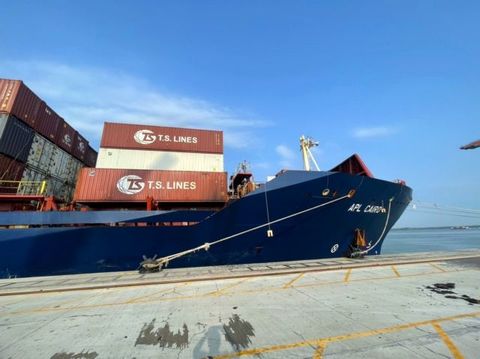
A container ship docks at the Gemalink Port in the Southern province of Bà Rịa-Vũng Tàu. — VNA/VNS Photo
Problems and solutions to the slowdown of global transport through the Red Sea were discussed during a meeting among business executives, officials from the Vietnam Maritime Administration and the Ministry of Industry and Trade (MoIT) yesterday in Hà Nội.
Trần Thanh Hải, Deputy Director of the Import-Export Department under the MoIT said as the Red Sea and the Suez Canal serve as a shortcut for ships traveling from European ports, the East Coast of North America to ports in South Asia, the East Coast of Africa and the Pacific, it remains one of the most vital maritime routes globally, accounting for approximately 12 per cent of the total global maritime traffic.
The crisis, due to conflict in the Middle East region, has forced shipping companies to change their routes, bypassing the Suez Canal and taking longer routes around the Cape of Good Hope, extending the journey by 10-15 days compared to before. The situation has been negatively impacting Việt Nam's import-export activities, especially with the European and North American regions.
In 2023, the Southeast Asian country's import-export turnover with Europe was US$71.14 billion, and $122.3 billion with North America. The total import-export turnover of these two regions alone accounted for 28.4 per cent of the country's total import-export value in 2023.
Some immediate negative impacts included increased transportation costs, more critically, a shortage of empty containers, extended transit times and adverse effects on the ability to fulfil import-export orders. In addition, the rise in transportation costs and oil prices will create a domino effect on the prices of other goods, leading to economic and geopolitical instability and hindering the global economic recovery, Hải said.
According to the Vietnam Maritime Administration, ship freight rates remained high. In January 2024, container shipping rates to the United States and Canada by sea have significantly increased compared to December 2023. Freight rates to the West Coast rose from $1,850/container in December 2023 to $2,873-$2,950/container in January 2024 (an increase of 55-60 per cent); rates to the East Coast in December 2023 were at $2,600/container, increasing to $4,100-$4,500/container in January 2024 (an increase of 58-73 per cent). Freight rates to the European market recorded a sharp increase compared to December 2023, with rates to Hamburg being $1,200-$1,300 in December 2023, rising to $4,350-$4,450 in January 2024.
As a result, real-time shipping data from the PortWatch platform, a joint initiative of the International Monetary Fund (IMF) and the University of Oxford, showed a 37 per cent decrease in cargo volume through the Suez Canal as of January 16, 2024, while cargo volume through the Cape of Good Hope has increased by 54 per cent during the same period.
In a response to difficulties faced by Vietnamese businesses, the MoIT has issued a number of documents advising associations, logistics service enterprises, and import-export businesses on solutions to mitigate the impacts of the Red Sea situation.
To minimise the negative impacts on Vietnamese businesses, management agencies, associations, and businesses during the meeting have proposed solution to stabilise freight rates and transportation fees.
They called for measures to support redirecting cargo using alternative routes, diversifying sources of goods supply, securing insurance contracts and enhancing coordination among businesses.
During the meeting, officials, association representatives, and directly affected businesses updated and shared useful information, highlighted difficulties and challenges, provided assessments of the situation, and proposed solutions, experiences and best practices.
Hải said by obtaining information as quickly as possible and accurately forecasting the most significant impacts appropriate coping measures can be implemented to minimise the negative effects for Vietnamese businesses. — VNS